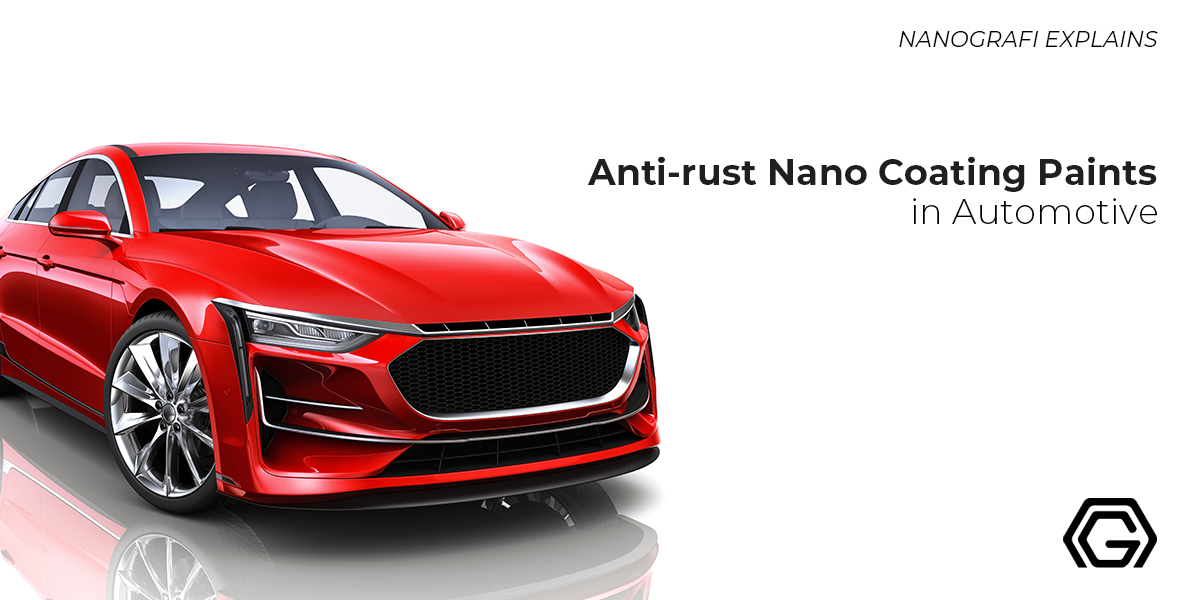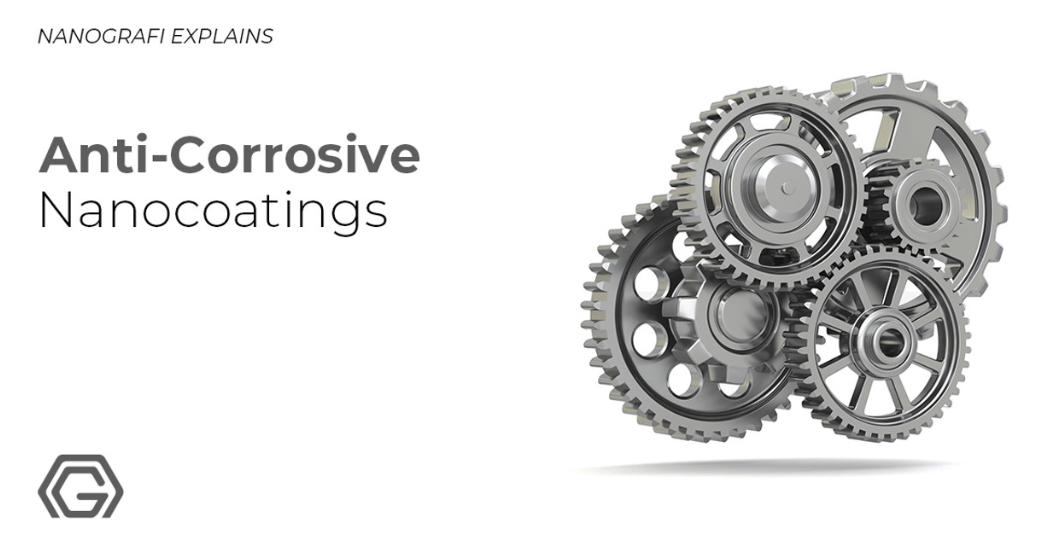Anti-rust Nano Coating Paints in Automotive
In the field of automotive innovation, the ongoing battle against corrosion is a significant challenge. Rust, which undermines both the lifespan and appearance of vehicles, has prompted the development of innovative solutions.
Among these, anti-rust nano coating paints stand out as a promising development. These paints offer not just protection against corrosion but also herald a new era of durability and resilience for various automotive parts. At the forefront of driving innovation in research and projects, Nanografi's advanced materials cover numerous sectors, including the automotive industry, to improve performance and sustainability.
Introduction
Corrosion is the process of wear and deterioration of materials through chemical or electrochemical reactions when exposed to environmental factors. This phenomenon, which is usually seen in metals, causes the metal to interact with oxygen, water, acids or other chemicals, causing its surface to wear, weaken and ultimately lose its function over time. Thanks to the advanced features offered by nanotechnology, it protects the surfaces of vehicles against harmful effects such as corrosion, scratches and UV rays, increasing durability and aesthetics.
Corrosion in Automotive Components
The automotive industry grapples with the enduring challenge of corrosion, especially in regions with harsh weather conditions or exposure to road salts. Unprotected metal surfaces, such as those found in car bumpers, are particularly susceptible to rust, compromising both the structural integrity and aesthetic appeal of vehicles.
Traditional methods are employed to combat corrosion in automobiles, including the use of primers, paints, and coatings. While these methods offer some level of protection, they often fall short in providing a robust and long-lasting shield against the relentless forces of rust.in I this context, nano coating paints are emerging as a solution.
Nano Coating Paints
The concept of nano coating paints highlights their nanoscale composition as a technological breakthrough. Nano coatings are engineered to have particles at the nanometer scale, offering unique properties that enhance their effectiveness in corrosion protection. Nano coatings represent a revolutionary leap in surface protection, leveraging nanoscale precision to redefine the properties of materials. Composed of nanoparticles like silica and graphene, these coatings offer unique advantages, from enhanced adhesion to self-assembly capabilities. Applications span diverse industries, enhancing automotive aesthetics, ensuring healthcare hygiene, and bolstering electronics' durability.
The phenomenon of superhydrophobicity, enabled by certain nano coatings, contributes to water-repellent surfaces. Environmental considerations, including green nanotechnology and regulatory standards, ensure responsible innovation.
To learn about the environmental impacts and challenges of nano-waste and what needs to be done to mitigate their possible harmful effects, visit our blog.
Looking ahead, the future holds promise of smart nano coatings, responsive to stimuli, and breakthroughs in nanomedicine. Ethical considerations guide the responsible use of nanotechnology, addressing privacy concerns and nanotoxicity risks. As surfaces become smarter and more resilient, nano coatings carve a path toward a future where precision at the nanoscale transforms the ordinary into the extraordinary.
Composition of Anti-Rust Nano Coating Paints
The composition of these advanced coatings explore the role of nanoparticles such as zinc oxide, silica, or graphene. Each component contributes to the overall effectiveness of the coating, providing attributes like increased adhesion, superior coverage, and enhanced resistance to environmental factors.
There are various application methods employed in applying nano coating paints to automotive surfaces. From spray applications to dip coating and electrodeposition, these techniques ensure uniform coverage and optimal adherence of the nano coating to the metal substrate.
The Role of Anti-Rust Nano Coating Paints in Bumper Protection
Bumpers, often an overlooked yet crucial component in automotive design, serve as the first line of defense against impacts and collisions. However, their exposure to environmental elements makes them susceptible to rust. They have significance in protecting bumpers and how anti-rust nano coating paints address this vulnerability.
Durability and Longevity
The application of nano coating paints extends the durability and longevity of bumpers. The nanoscale protective layer forms an impermeable shield, preventing moisture and corrosive agents from reaching the metal surface, thereby significantly reducing the risk of rust formation.
Enhanced Aesthetic Appeal
There are aesthetic benefits of anti-rust nano coating paints on bumpers. The coatings not only provide a protective layer but also maintain the visual appeal of the vehicle. This ensures that the vehicle's exterior remains pristine and appealing, contributing to its overall resale value.
Have you heard of anti-corrosive nanocoatings before? Learn now.
Advantages of Anti-Rust Nano Coating Paints
Exceptional Adhesion and Coverage
The superior adhesion properties of nano coating paints ensure comprehensive coverage on the substrate. The nanoscale particles form a tight bond with the metal surface, leaving no room for the corrosive agents to infiltrate.
Resistance to Environmental Factors
Anti-rust nano coating paints offer resistance to a wide range of environmental factors, including UV radiation, humidity, and temperature variations. This resistance is crucial for ensuring the longevity of the coating and, consequently, the protection of automotive components.
Self-Healing Properties
Introduce the concept of self-healing properties in some advanced nano coatings. These coatings have the ability to repair minor scratches or damages over time, further enhancing their resilience and maintaining the protective barrier against rust.
Challenges and Considerations
The application of anti-rust nano coating paints may come with an associated cost. The initial investment in these coatings is outweighed by the long-term benefits, such as reduced maintenance costs and prolonged component lifespan.
In addition, there are concerns regarding the environmental impact of nano coating paints. The ongoing researches and efforts within the industry are done to develop eco-friendly formulations that minimize any potential negative effects on the environment.
Future Developments and Innovations
Ongoing research and developments in nano coating technologies are significantly advancing the field of anti-rust protection, showcasing the potential of integrating nanomaterials with self-repairing capabilities. This integration not only pushes the boundaries of durability and efficiency but also marks a pivotal shift in the application methodologies of nano-coating paints.
Emerging technologies, such as robotic application systems and 3D printing, are at the forefront of revolutionizing how these coatings are applied to automotive components. These advancements are not only optimizing the protective qualities of coatings but also enhancing the precision and efficiency of their application, paving the way for more sustainable and long-lasting solutions in the automotive industry.
Conclusion
The occurrence of corrosion in the automotive industry is taking on an innovative dimension thanks to nano-coating technologies. These technologies utilise the superior adhesion and durability properties offered by nanoparticles such as zinc oxide, silica and graphene to extend the life and visual appeal of vehicles. Nano-coatings form an impermeable barrier on metal surfaces, providing effective protection against rust formation and thus increasing the resistance of automotive components to environmental influences. The application of this technology represents an important step towards sustainable automotive solutions and supports the search for innovation in the industry.
To follow the latest developments and innovations related to nanotechnology, visit Blografi.
References
Anti-Corrosive Nanocoatings - Nanografi Nano Technology. (n.d.). Retrieved February 19, 2024, from https://nanografi.com/blog/anticorrosive-nanocoatings/
Best Rust Prevention Spray & Paint 2021 | Car Underbody Protection. (n.d.). Retrieved February 20, 2024, from https://procarreviews.com/best-rustproofing/
How Nano Coating prevents rust - Onyx Coating. (n.d.). Retrieved February 20, 2024, from https://onyxcoating.com/nano-coating/how-nano-coating-prevents-rust/
Nano-waste Problems and Sustainable Nanotechnology - Nanografi Nano Technology. (n.d.). Retrieved February 19, 2024, from https://nanografi.com/blog/nanowaste-problems-and-sustainable-nanotechnology/
Using Ceramic Coating to Prevent Rust - Ceramic Pro. (n.d.). Retrieved February 20, 2024, from https://ceramicpro.com/using-ceramic-coating-to-prevent-rust/
What is Graphene: The Ultimate Guide - Nanografi Nano Technology. (n.d.). Retrieved February 19, 2024, from https://nanografi.com/blog/what-is-graphene-the-ultimate-guide/
Recent Posts
-
Advanced Materials for Unmanned Aerial Vehicle (UAV) Protection Against Laser
Consider a UAV on a critical mission, rendered inoperative by a sudden laser attack. With the increa …26th Jul 2024 -
Simulation and Modeling of Material Properties
Our world is composed of a dazzling array of materials, each with its own unique properties that dic …19th Jul 2024 -
Advanced Coatings for Superior Corrosion and Wear Resistance
Corrosion and wear pose significant challenges across various industries, leading to substantial eco …12th Jul 2024






